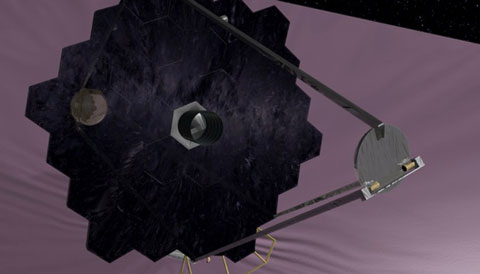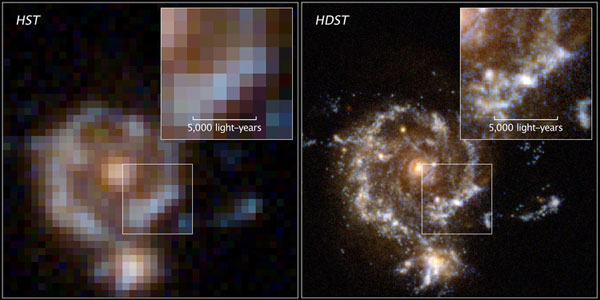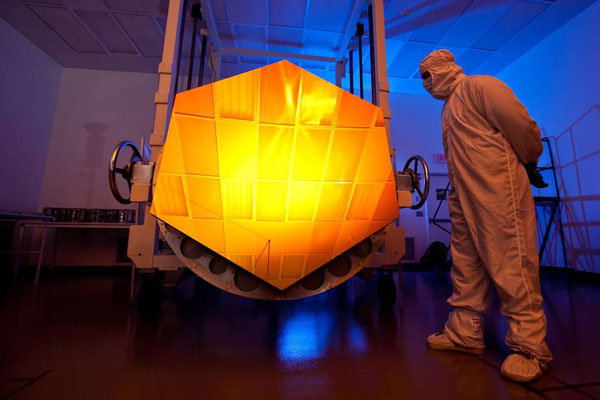A proposal released earlier this month calls for a giant orbiting space telescope that could revolutionize astronomy — that is, if we can afford it.

NASA/GSFC
A consortium of 40 international affiliates and U.S. institutions known as the Association of Universities for Research in Astronomy (AURA) recently unveiled a proposal to orbit a large, segmented-mirror telescope more than five times the diameter of the Hubble Space Telescope. Dubbed the High Definition Space Telescope (HDST), this instrument would peer deeper in space and time than ever before and enable astronomers to directly image nearby Earth-like exoplanets.
The HDST proposal calls for a segmented mirror 39 feet (12 meters) in aperture, which would be placed at the L2 Lagrange point, a stable region where the gravitational influences from the Sun and Earth balance out. The Sun-Earth L2 point is located 932,000 miles (1.5 million kilometers) anti-sunward from the Earth. HDST’s diameter would almost double the effective diameter of the James Webb Space Telescope, set to launch in 2018 for the same L2 orbit.
Though the JWST has often been touted as the "successor to Hubble," it’s primarily an infrared workhorse. The HDST would — like Hubble — work at ultraviolet and near-infrared wavelengths, as well as visible light.
What HDST Can Do

Association of Universities for Research in Astronomy (AURA)
“There is no area of astronomy and astrophysics that HDST will not impact,” says Mario Livio (Space Telescope Science Institute). “Arguably, the most fascinating topic would be the ability to image dozens of extrasolar Earth-like planets in the habitable zones of their parent stars, and to characterize their atmospheres. This will enable us either to detect extrasolar life, if such life is common, or at least place meaningful constraints on how rare extrasolar life is.”
Composed of 54 mirror segments, HDST would also be outfitted with a starlight-blocking coronagraph, enabling it to directly image exoplanets around stars up to 100 light-years away. Such a device could be built into the structure of the telescope, or, even better, could consist of a free-flying occulting disk thousands of kilometers away. The HDST would also be capable of resolving structures 330 light-years across in the universe when it was just 3 billion years old (that is, out to a redshift of 2.)
The proposed megascope would provide images up to 24 times sharper than those from Hubble. “HDST will have an important impact on solar system studies,” says Marc Postman (Space Telescope Science Institute). “We could monitor outer planets and satellites on long timescales. The images of Pluto that HDST would get would be similar in detail to those released by New Horizons when it was about three weeks out from closest approach. HDST would be able to detect features the size of the island of Manhattan on Jupiter. It would also be able to search for more distant and very faint Kuiper belt objects out beyond Pluto.”
From Concept to Reality

Drew Noel / NASA
But getting HDST to space won’t be easy. Take JWST: that project was plagued with cost overruns for years, culminating in the threat of cancellation in 2011. Although it’s on track for a 2018 launch, JWST's budget is now nearly $9 billion, after an initial budget proposal of $1.6 billion. There’s no official budget allocated to the HDST as of yet, and it’s still early in the game to make an official cost estimate, but unofficial estimates put it in the ballpark of $10 billion. The lessons learned from JWST, such as development, design, and getting the observatory from the drawing board to orbit, will prove crucial to HDST.
HDST does have some advantages in the cost department. It can operate at much warmer temperatures than JWST will, and it does not require extensive cryogenic testing on Earth. Construction of the HDST can also utilize low-cost optical materials and simpler component design.
The project envisions the telescope to be folded up for launch aboard a NASA Space Launch System (SLS) rocket sometime in the 2030s. NASA plans to test its SLS rocket in November 2018. Like JWST, HDST would be out of range for repairs once deployed, and it would have to unfold and operate successfully on its own. It remains to be seen how this will work out for JWST and HDST alike, since Hubble required immediate repair following its launch in 1990. The crew of space shuttle Atlantis serviced Hubble one last time in 2009, so failure of any key component of Hubble now means the loss of a crucial instrument with visible-light capabilities, an asset that may not be replaced for years to come.
The Hubble Space Telescope overcame budget and engineering problems to usher in a new era of astronomy. Perhaps the promise of the High Definition Space Telescope will do the same in the decades to come.
Sky & Telescope chronicles 25 years of Hubble Space Telescope achievements in our June 2015 issue.
 5
5
Comments
Michael -Cardoza
July 22, 2015 at 4:10 pm
You know what makes me nervous about this? S&T just had an issue talking about all the issues that plague large aperture telescopes. They almost never function on first light and have mechanical issues. Just look at Hubble. Now we are talking about launching a large aperture telescope to an orbit where it cannot be serviced currently. If that thing has a problem it will become just a piece of floating debris.
You must be logged in to post a comment.
Peter Wilson
July 23, 2015 at 9:42 am
Assuming they'll do a thorough test in Low Earth Orbit, but rocketing the unfurled telescope, from LEO to L2, surely has its own problems/risks.
You must be logged in to post a comment.
Kevin
July 24, 2015 at 10:58 pm
Whenever I hear, "How are we going to pay for that?" in the field of space exploration I immediately think of our bloated defense budget. The current budget is set at $530 billion -- wouldn't it be nice if the DOD could somehow scrape by on $520 billion and allow us to build this telescope? Today's threats are very different than they were 30 years ago and it's time to trim that budget considerably.
You must be logged in to post a comment.
bwana
July 26, 2015 at 4:18 pm
Only $10 billion!? If the USA wasn't so hell bent on military spending, they could build 50 of these with spare change left over!
You must be logged in to post a comment.
Mycroft
July 27, 2015 at 12:04 pm
Hey, a mission for the Orion spacecraft. Servicing telescopes at the Lagrange points!
With new threats appearing and old ones coming back, I don't know if you could take a few billion from DOD right now though.
You must be logged in to post a comment.
You must be logged in to post a comment.